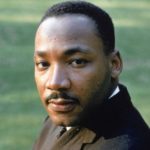The power of nonviolent actions and attitudes as a means to resist oppression and spur reforms is a recurring feature of democratic and democratizing societies. The School Violence Prevention Demonstration Program presents educators with lesson plans that explore the use of nonviolence in history, paying particular attention to the civil rights movement and African American history. Six lessons address: the 1963 Children’s March; the concept of nonviolence using primary sources and stories of participants in the civil rights movement; the power of nonviolence; the story of Rosa Parks; citizenship schools; how music can be used to achieve social and political change.
Martin Luther King, Jr., and the Power of Nonviolence

This lesson introduces students to Martin Luther King, Jr.’s philosophy of nonviolence and the teachings of Mohandas K. Gandhi that influenced King’s views. After considering the political impact of this philosophy, students explore its relevance to personal life. (Duration: 2 class periods)
Learning Objectives:
To examine the philosophy of nonviolence developed by Martin Luther King, Jr.
To consider how this philosophy translated into practice during the Civil Rights Movement.
To explore the relationship between King’s teachings on nonviolence and those of Mohandas K. Gandhi.
To reflect on the relevance of nonviolence to one’s personal conduct in everyday life.
The Power of Nonviolence: Rosa Parks: A Quest for Equal Protection Under the Law
This lesson asks students to revisit the well-known story of a figure in the civil rights movement–Rosa Parks–through the primary source documents associated with her arrest in 1955. The arrest occurred in the shadow of the Supreme Court decision in Brown v. Board of Education of Topeka, Kansas (1954) and had a powerful impact on the public policy of segregation and the application of the equal protection clause of the Fourteenth Amendment.
Competing Voices of the Civil Rights Movement
When most people think of the Civil Rights Movement in America, they think of Martin Luther King, Jr. delivering his “I Have a Dream” speech on the steps of the Lincoln Memorial in 1963 and receiving the Nobel Peace Prize the following year. But “the Movement” achieved its greatest results — the 1964 Civil Rights Act and the 1965 Voting Rights Act — due to the competing strategies and agendas of diverse individuals. Even black Americans, the primary beneficiaries of this landmark legislation, did not agree on the tactics that should be used to secure the equal protection of their rights. This unit presents the views of several important black leaders who shaped the debate over how to achieve freedom and equality in a nation that had long denied a portion of the American citizenry the full protection of their rights.
Civil Rights Movement: Sit-Ins
By the 1960s, the Civil Rights movement was growing in the U.S. Leaders such as Martin Luther King Jr. employed non-violent methods of protesting. On February 1, 1960 students in Greenville, NC engaged in a new peaceful tactic, a sit-in. This launched a wave of sit-ins across the country. In this lesson, students will hear about the circumstances that unfolded that day and hits impact on the country.